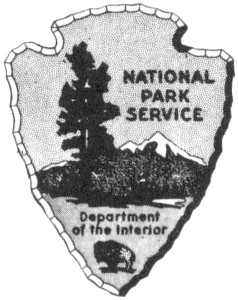
CAMPFIRE TALES
of
JACKSON HOLE

Cover Design, Cartography, and Sketches
By G. Bryan Harry, former Asst. Chief Park Naturalist
Photographs Courtesy of the National Park Service
Unless Otherwise Credited
Published by the
GRAND TETON NATURAL HISTORY ASSOCIATION
MOOSE, WYOMING 83012

In Cooperation with the
NATIONAL PARK SERVICE U.S. DEPARTMENT OF INTERIOR
COPYRIGHT, GRAND TETON NATURAL HISTORY ASSOCIATION, 1960
4TH PRINTING, 1970
FOREWORD
Man’s search for wealth has taken him to many out of the way places.Wealth can assume many forms, depending on the person striving for it.
What is now Jackson Hole was a way of life to the Indians whosummered here and wintered in the lower and warmer regions to theeast of Togwotee Pass. A summer in this secluded valley meant plentifulfish and other wildlife for food, skins for clothing and teepees aswell as a cool, well-watered environment.
Snowmelt fed streams, bordered by vegetation, supported many beaverand other fur bearers that attracted men of European descent in theirnever-ending quest of commercial wealth. Colter was followed by othermountain men and trappers who considered the natural resources of thearea as there to be taken for their own personal gain. By 1840 beaverbecame scarce and fell from fashion. The land that supported bisonwas thought good for domestic cattle, so ranchers settled in JacksonHole from one end to the other. Dry years and the Great Depressionforced many of them to sell out.
Now millions of visitors come each year to recapture the thrill ofwandering in a land still much as the Indians left it. This is a newwealth that depreciates little under protection as a National Park.
An increasing number of people look for ways to identify themselveswith those who led the way into this new land. Campfire Tales ofJackson Hole gives you this opportunity in an easy to read text thattakes you back to the people and events that transpired in the valleythat surrounds you.
THE PARK STAFFGrand Teton National Park
CONTENTS
- Page
- John Colter, The Discovery of Jackson Hole and the Yellowstone 4
- The Mountain Men in Jackson Hole 11
- The Doane Expedition of 1876-1877 20
- Map of the Region 30-31
- The Story of Deadman’s Bar 38
- The Affair at Cunningham’s Ranch 43
- Prospector of Jackson Hole 47
- Mountain River ...
BU KİTABI OKUMAK İÇİN ÜYE OLUN VEYA GİRİŞ YAPIN!
Sitemize Üyelik ÜCRETSİZDİR!